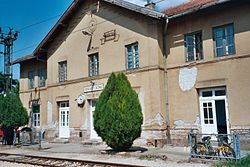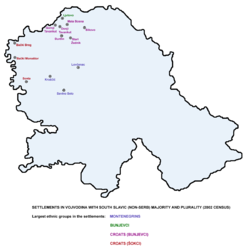- Montenegrins of Vojvodina
-
Part of a series on Montenegrins 
By region or country Recognized populations Montenegrins
Serbia (Vojvodina)
Kosovo
Bosnia and Herzegovina
Croatia
Republic of Macedonia
AlbaniaAustria · Denmark
France · Germany
Italy · Luxembourg
Russia · Slovenia
Sweden · Switzerland
United KingdomNorth America
United States · CanadaSouth America
Chile · Argentina
Bolivia · Brazil · ColombiaOceania
Australia · New ZealandCulture Literature · Music · Art · Cinema
Cuisine · Dress · SportReligion Roman Catholicism
IslamLanguage and dialects Montenegrin History History of Montenegro
RulersMontenegrins are the sixth largest ethnic community in the Vojvodina province of Serbia. According to the 2002 census, there are 35,513 Montenegrins in Vojvodina, constituting 1.75% of the population of the province. The Montenegrin population in Vojvodina is larger than that in Central Serbia, where number of Montenegrins recorded by the 2002 census was 33,536.
Contents
Language and religion
Montenegrins in Vojvodina speak Serbian and Montenegrin and the supermajority are adherents of the Serbian Orthodox Church. There is also an initiative for construction of the church building of the Montenegrin Orthodox Church in Lovćenac.
Geography
The largest concentration of Montenegrins in Vojvodina could be found in the municipalities of Vrbas (24.79%), Mali Iđoš (20.83%), and Kula (16.34%). Settlements in Vojvodina with absolute or relative Montenegrin majority are: Lovćenac in the Mali Iđoš municipality with 56.86% Montenegrins, Kruščić in the Kula municipality with 32.64% Montenegrins, and Savino Selo in the Vrbas municipality with 38.20% Montenegrins. Formerly, the village of Bačko Dobro Polje in the Vrbas municipality also had a Montenegrin majority (According to the 1971 census, Montenegrins comprised 55.39% of population of this village, while according to the 2002 census, the current population of the village is composed of 57.17% Serbs and 38.18% Montenegrins).
Historical population
 The train station in Lovćenac in 2003
The train station in Lovćenac in 2003
Montenegrin population in Vojvodina according to the various censuses:
- 1948: 30,589 (1.9%)
- 1953: 30,516 (1.8%)
- 1961: 34,782 (1.9%)
- 1971: 36,416 (1.9%)
- 1981: 43,304 (2.1%)
- 1991: 47,289 (2.3%)
- 2002: 35,513 (1.75%)
Organizations
The society of Montenegrins in Serbia, known as "Krstaš", is based in Lovćenac.
See also
External links
Ethnic groups in Serbia Central Serbia Serbs · Albanians · Bosniaks · Ethnic Muslims · Bulgarians · Croats · Macedonians · Montenegrins · Roma · Romanians (Vlachs) · YugoslavsVojvodina Banat Bulgarians · Bunjevci · Croats (Šokci) · Germans (Danube Swabians and Banat Swabians) · Hungarians (Szekelys) · Montenegrins · Macedonians · Pannonian Rusyns · Roma · Serbs · Slovaks · Yugoslavs · Romanians · Czechs · Slovenes · Gorani people · Ukrainians · Albanians · RussiansKosovo[a] ^a Kosovo is the subject of a territorial dispute between the Republic of Serbia and the self-proclaimed Republic of Kosovo. It declared independence on 17 February 2008, while Serbia claims it as part of its own sovereign territory. Its independence is recognised by 85 UN member states.Categories:- Montenegrin people
- Montenegrin diaspora
- Ethnic groups in Vojvodina
- Serbia stubs
- European ethnic group stubs
- Montenegro stubs
Wikimedia Foundation. 2010.


